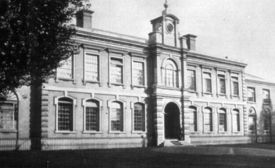From Jamaica to Mellor – An Apprentice’s Tale
A recent request from Janet Davies enquiring about her husband’s ancestor, Ann Maria Vanpine, led to a search on line and in our archives. From these it is possible to learn about some periods in Ann’s life.
The Duke of York’s Royal Military Asylum (right) records Ann’s admission to the Southampton Branch at the age of 10 on the 5th December 1821. This was a separate branch of the Chelsea RMA and was exclusive to girls. It was established as a haven for the orphaned children of soldiers who had fallen in the war with France 1793 to 1815 (Battle of Waterloo).
Ann’s father was Corporal John Vanpine of the 60th Foot (The Royal American Regiment). At the time of her admission he was deceased but her mother was still living. It was thought, and we have later confirmed from local census records, that Ann was born in Jamaica. If Ann’s mother was of Caribbean-African heritage it is more than likely that Ann was born a “daughter of the regiment”. Ann’s parents must have been legally married or their daughter would not have been admitted to the RMA. The Institution’s constitution denied access to all children born out of wedlock. Ann spent four years at the RMA, which should have given her a good grasp of the three R’s, if not more.
The next chapter in Ann’s life starts with her departure to be apprenticed at Samuel Oldknow’s mill in Mellor on the 1st December 1825. There were a number of children sent from the RMA at this time to be apprenticed in the North West. A list of 85 such children (1815 to 1829) gives their ages at admission and discharge. When leaving most were aged 13 to 15. Of the 85 listed, Oldknow received 62 (all girls) whilst the remaining few (16 boys and 7 girls) went to employers in Heyside in the Oldham area. Some records at Heyside of terrible ill treatment compare with more favourable accounts that Oldknow was a good employer although he was quite capable of getting more years of apprenticeship out of his workers than he was entitled to. Jane Rowley was discharged and sent to Oldknow’s mill on the same day as Ann. Each child leaving the Asylum was presented with a small bible containing quotations appropriate to the moral education of the recipient. We have the front cover of Ann’s bible in the archives.
There were not many men employed at Mellor Mill, but Ann managed to secure one as a husband. In 1834 she married Henry Roe Wigley at Mottram. Henry was born at Tissington, Derbyshire, circa 1813, and, from subsequent events, it would be interesting to know what education he had. There was a spinning mill at Tissington and there were cotton workers named on the 1841 and 1851 censuses there. It is therefore quite possible that Henry was already an experienced cotton operative when his family arrived in Marple.
interesting to know what education he had. There was a spinning mill at Tissington and there were cotton workers named on the 1841 and 1851 censuses there. It is therefore quite possible that Henry was already an experienced cotton operative when his family arrived in Marple.
The 1841 census finds Henry and Ann living on Brick Row, Marple, but by 1851 they had moved to Red Row, Mellor. Both of these were properties for the mill employees. They had two children, John and Emily, sadly Emily died at about the age of 11. In 1851 they opened a school in the Wesleyan Methodist Association Schoolroom, Mellor. We know that Ann was educated at the RMA but we have no knowledge yet about Henry’s abilities in this respect. An advertising poster was produced but, significantly (19th century ideas about women’s place!), Ann’s name is not mentioned. It is Mr H R Wigley announcing that he intends opening a Day and Evening School. Also, although there is a very comprehensive list of subjects, it seems that girls were not being included in the offer of this education. Near the bottom of the poster it states “The GIRLS will be duly attended to, as soon as circumstances will allow, and TAUGHT SEWING AND KNITTING” We have to wonder what Ann thought of this!
Census records 1851–1881 show Henry and Ann living in Red Row and neither of them is referred to as a teacher. Apart from 1861, when Henry’s occupation is said to be a coal carrier, they are both described as cotton operatives or formerly cotton operatives. However, we are led to believe that the school was a successful enterprise. So far our research has revealed no evidence of this but Gladys Swindells writes in “A history of Marple” that the Wigley’s grandson recalls “My grandfather had a school in the bottom part of New house Hill Chapel till he was an old man and his schooling days were finished. I can’t remember if anyone else did teach”. It seems that Ann is being overlooked again even though she outlived Henry by eight years, dying in 1890 aged 83. We believe that Ann must have played an important part in the teaching process of this school and that there may be local families who have some record of this in their ancestry. Any further details to add to the tale of this apprentice would be very much appreciated.

